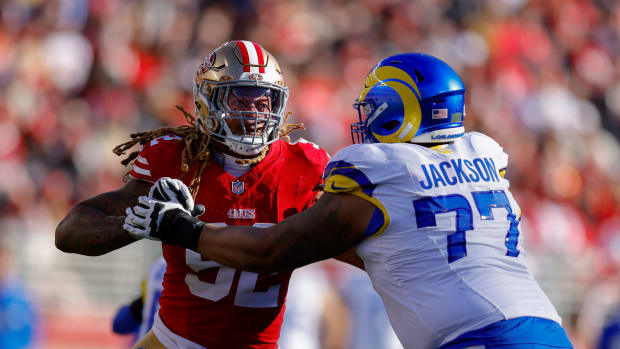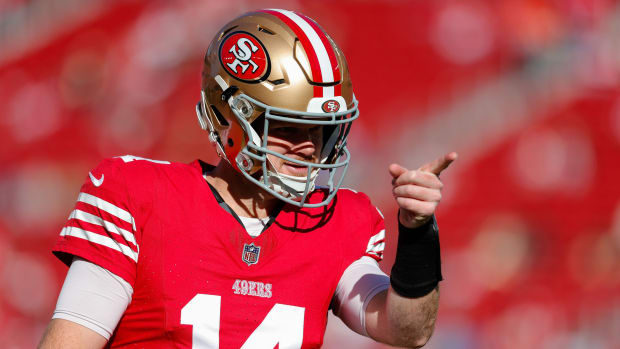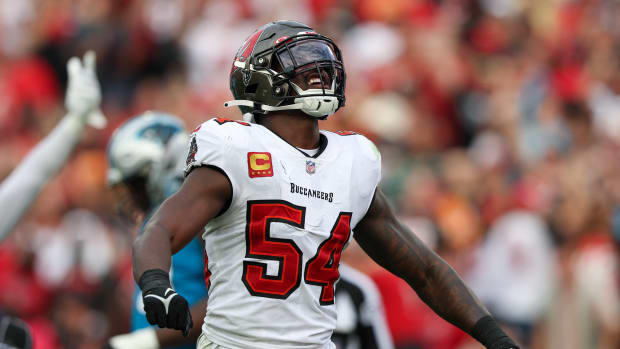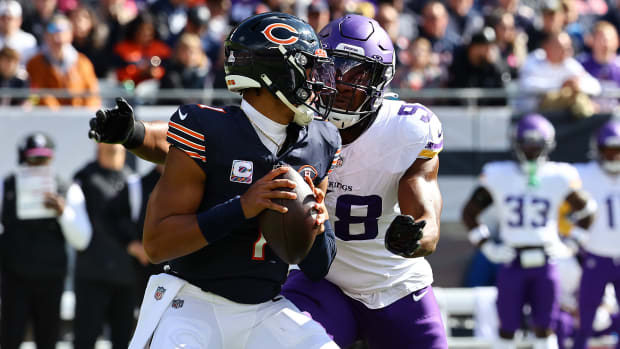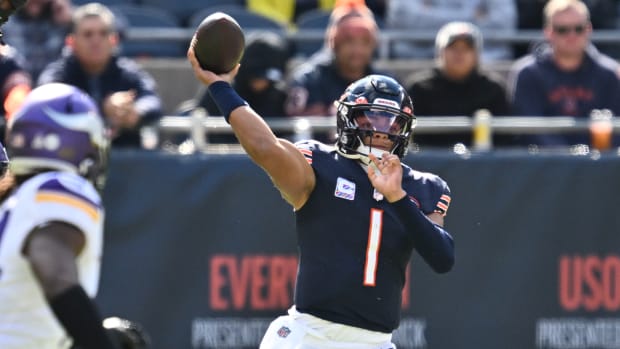2017 NFL draft first impressions: Corey Davis’s polished WR skill set
Your teams on the go or at home. Personalize SI with our new App. Install on iOS or Android.
It is never too early to start preparing for the next NFL draft. From now through the start of the college football season, “First Impressions” will introduce (or reintroduce) you to a handful of notable prospects worth keeping an eye on this fall for amateur talent evaluators and NFL-conscious college fans alike.
Over the final six games of Western Michigan’s 2015 regular season, wide receiver Corey Davis averaged 133.7 yards and a touchdown. He capped his junior year by making eight catches for 183 yards on Middle Tennessee State during a Bahamas Bowl victory–the first bowl win in program history.
Had he turned pro right then, Davis likely would have landed among the top 100 selections in the 2016 draft. In fact his coach, P. J. Fleck, who arrived at Western Michigan off a one-year stop as a Tampa Bay Buccaneers assistant in 2012, believes Davis was pretty darn close to being NFL-ready even earlier.
“I would have taken him in Tampa Bay after his sophomore year as our third receiver,” Fleck says.
Instead, Davis will be Fleck’s unquestioned WR1 back in Kalamazoo, and the 6' 3" pass-catcher could wind up as the top prospect at his position in the 2017 draft. Davis finished last year with 89 receptions for 1,429 yards and 12 touchdowns, pairing with Daniel Braverman (108 catches for 1,367 yards and 13) to form a dominant pairing.
Surprisingly it was Braverman, a slot receiver, who decided to test the NFL waters early while Davis stayed in school. Braverman was taken in the seventh round by the Bears. The bar for Davis is set much higher.
“Corey Davises don’t come along very often,” Fleck says. “If they have one talent, then they really lack something else. Corey's really the complete package.”
And he has room to get better. A major focus for Davis this off-season has been adding weight to his frame. He was listed at a rather lanky 205 pounds a year ago, and the lack of bulk showed up on occasion, particularly when he was asked to block. According to Fleck, Davis is already up to 215, with a full summer still to go. “He’s quicker, more explosive,” Fleck says. “He has spent a ton of time just working on his craft, to get him better. He’s our best player but also our hardest worker.”
Why Ryan Fitzpatrick, Jets won’t find a better fit by parting ways
Should Davis’s added weight result in increased strength as a blocker, route runner vs. press coverage and in contested-catch situations, then the criticisms of his game might be reduced to nitpicking. His frame would be that of an outside receiver. That said, Davis has lined up just about everywhere for the Broncos, including inside. Fleck calls that versatility “extremely rare” for a player of Davis's size: “It’s the reason why he’s being talked about in the first two rounds. When you find one, you draft him. There might be guys that can do it, but to do it very well, that’s another thing.”
Fleck has put Davis in contact with Buccaneers veteran Vincent Jackson, whom Fleck calls “the greatest pro I’ve been around.” Jackson produced a career-best season (1,384 yards and a league-leading 19.2 yards per catch) during Fleck’s brief tenure as receivers coach in Tampa Bay.
Does Fleck see any similarities between his current and former star pupils?
“Corey’s got a little more quickness to him, but Vincent’s 6' 5 1/2". He’s got that rare, elite length. Corey’s got length but he doesn’t have that length,” Fleck says. “Vincent was huge and he could run like Corey. Vincent worked on his game to become more of a medium-range to vertical passing game threat. Corey's got even more of the underneath stuff very well.”
Can the NFL escape the depths of its own corruption?
Davis’s brother, Titus, racked up 3,700 yards receiving and 37 touchdowns during his impressive career at Central Michigan. He is now with the Jets on a reserve/futures contract.
Corey Davis is all but certain to finish with family bragging rights. He is sitting on 3,778 yards and 33 touchdowns, putting him within striking distance of the MAC all-time record in each category. Another former Western Michigan standout, Jordan White, holds the yardage mark at 4,187; Marshall's Darius Watts sits atop the TD list with 47.
Western Michigan opens with a trip to Northwestern and also visits Illinois before the MAC schedule begins, so there should be several opportunities to check out Davis this season. His name certainly will stay in the early-round draft discussion, if all goes according to plan.
Second Opinion: Corey Davis
Each First Impressions column will feature an additional take on the featured player from Sports Illustrated NFL producer Eric Single. Here are his thoughts on Davis:
New amicus briefs try to show Tom Brady's case is relevant beyond NFL
I get an Alshon Jeffery vibe from watching Davis, who shouldn’t be as elusive after the catch as he is and can burn smaller defenders in the open field. That split-second gear shift he takes at the moment of each reception, transitioning from a loping possession receiver creating space for himself into a fluid playmaker turning upfield and looking to juke would-be tacklers, is harder to believe every time it happens.
When lined up in the slot or targeted within the staple plays of Western Michigan’s quick-strike offense, his footwork is a huge matchup problem for defenses: His go-to move is a subtle, repeatable half-speed stutter step that only opponents’ top outside corners seem to be able to stay with. (Kudos to Eli Apple, who helped Ohio State limit Davis to six catches for 42 yards after the Broncos found some early success with back-shoulder throws to the sideline.) On the outside, he can leave you wondering why a guy his size doesn’t win more jump balls, but he has room to add some muscle. Even with his off-season gains he gives up at least 10 pounds to what Jeffery was listed at in his final year at South Carolina.
With Braverman now in Chicago, the Broncos’ passing game falls on Davis’s shoulders this year. His Big Ten showcases this fall won’t get quite the spotlight last year’s did—Northwestern and Illinois are a significant step down from last September’s dates with Michigan State and Ohio State—but putting up a few big afternoons in the face of increased defensive attention would still be an effective way to distinguish himself.
[youtube:https://www.youtube.com/watch?v=QxdkKBlBN1Y]
2017 NFL Mock Draft
2017 NFL Mock Draft
1. Cleveland Browns: Brad Kaaya, QB, Miami
2. San Francisco 49ers: Deshaun Watson, QB, Clemson
3. San Diego Chargers: Cam Robinson, OT, Alabama
4. Tennessee Titans: Myles Garrett, DE, Texas A&M
5. Jacksonville Jaguars: Leonard Fournette, RB, LSU
6. Tampa Bay Buccaneers: Carl Lawson, DE, Auburn
7. Cleveland Browns (via Eagles): Roderick Johnson, OT, Florida State
8. Detroit Lions: Jalen Tabor, CB, Florida
9. New Orleans Saints: Christian McCaffrey, RB, Stanford
10. Miami Dolphins: Jonathan Allen, DE, Alabama
11. Tennessee Titans (via Rams): Desmond King, CB, Iowa
12. Atlanta Falcons: Mike Williams, WR, Clemson
13. Buffalo Bills: Dalvin Cook, RB, Florida State
14. Houston Texans: Jabrill Peppers, S/LB, Michigan
15. Washington Redskins: Eddie Vanderdoes, DT, UCLA
16. Chicago Bears: Patrick Mahomes, QB, Texas Tech
17. New York Jets: DeMarcus Walker, DE, Florida State
18. Baltimore Ravens: Tim Williams, OLB, Alabama
19: New York Giants: Raekwon McMillan, LB, Ohio State
20: Oakland Raiders: Adoree' Jackson, CB, USC
21: Kansas City Chiefs: Jarrad Davis, LB, Florida
22: Indianapolis Colts: Derek Barnett, DE, Tennessee
23: Minnesota Vikings: O.J. Howard, TE, Alabama
24: Dallas Cowboys: Jourdan Lewis, CB, Michigan
25: Cincinnati Bengals: Malik McDowell, DT, Michigan State
26: Arizona Cardinals: Pat Elflein, G/C, Ohio State
27: Denver Broncos: Tony Conner, S, Ole Miss
28: Carolina Panthers: Charles Harris, DE, Missouri
29: Green Bay Packers: Corey Davis, WR, Western Michigan
30: Pittsburgh Steelers: Baker Mayfield, QB, Oklahoma
31: Seattle Seahawks: Carlos Watkins, DT, Clemson
32: New England Patriots: Cooper Kupp, WR, Eastern Washington
Which other talented prospects should you have on your 2017 draft radar? Here are a few more to consider:
Marquis Haynes, Edge, Ole Miss
The skinny: Junior, 6' 3" and 220 lbs. All-SEC Freshman team honoree in 2014, then named second-team All-SEC last year. Made four starts as a true freshman and a dozen in 2015.
The 2015 stats: 43 tackles, 16.5 tackles for loss, 10.0 sacks, three forced fumbles.
The tape (Haynes is No. 10 in the video):
Check out those stats. Hayes can be an absolute nightmare off the edge for opposing blockers. If only it were that simple when it comes to figuring out his NFL place.
Haynes wreaks havoc in the backfield thanks to a remarkable, shot-out-of-a-cannon first step. He complements it with the quickness to bend the edge or blow past an interior lineman when stunting. His production no doubt will have him on the draft radar through this year (and next, should he stay into 2017); his limited size will force teams to project out his role perhaps a bit more than they would like.
Because he stands in that 220-lb. range, Haynes almost has to be viewed as a pass-rushing outside linebacker as opposed to a defensive end. He does not have the strength to hold up an edge, as stronger OTs repeatedly force him to run wide around them to reach the ball carrier.
Week Under Review: NFL teams should stay far away from Art Briles
Haynes has flashed the athleticism to drop in coverage or play wide vs. the run, but will NFL teams trust him to do it on a consistent basis? The final verdict will be even tougher to come by should Haynes leave after this season, because he would not be eligible to participate in the Senior Bowl—other DE-to-OLB converts have used that week to prove themselves.
He has a pro future, no question. His draft stock will boil down to whether teams view him as an undersized but dynamic defensive chip or as a productive college star without an obvious position.
Gunner Kiel, QB, Cincinnati
The skinny: Redshirt senior, 6' 4" and 215 lbs. Transferred from Notre Dame after the 2012 season. Tied the Cincinnati single-season record for passing TDs, with 31 in 2014. Missed time due to multiple head injuries last season, and also was absent from the team’s bowl game due to an undisclosed personal matter.
The 2015 stats: 206 of 316 passing for 2,777 yards, 19 touchdowns and 11 interceptions. Two rushing TDs.
The tape:
Fair or not, Kiel likely will have to answer for the strange route he took to Cincinnati’s QB job—the eventual five-star recruit decommitted from both Indiana and LSU before signing at Notre Dame, then transferred out of South Bend after one season. This coming year will mark his third as the Bearcats’ No. 1 quarterback, assuming Kiel reclaims that job after his bowl absence.
There is a lot to like in his game, starting (as NFL teams usually do at quarterback) with his size. His arm strength should go down as a plus, too, at least when it comes to getting the ball deep. Cincinnati’s passing attack has landed a number of huge plays under Kiel’s watch, and the experienced QB shows no qualms about giving his receivers chances in traffic.
The two areas in which Kiel must improve are his footwork and pace. The former will be prioritized by scouts because of Kiel’s experience in Cincinnati’s shotgun-based spread attack. But more than that, Kiel will throw off his back foot several times per game with little follow through, finishing his passes facing parallel to the line of scrimmage. As for the latter, while he does go through his progressions, it takes time—he wants that first read. Kiel almost never bails on the pocket unless it’s in the play design, meaning he relies on his protection to keep him clean. If there is a quick first read available or the defense cannot generate pressure, Kiel moves within the pocket to find a target; if either of those elements changes, he has problems.
Kiel does have enough mobility to run, usually on read-options, but he may not do much of it given the pair of head injuries he suffered as a redshirt junior.
Cameron Sutton, CB, Tennessee
The skinny:Senior, 5' 11" and 186 lbs. Has started 38 of a possible 38 games thus far in his career. Six career INTs and 26 pass breakups. Averages 16.0 yards per attempt on punt returns.
The 2015 stats: 28 tackles, three tackles for loss, six pass breakups, one INT, 467 yards and two touchdowns on 25 punt returns.
The tape:
Sutton is listed just shy of the coveted cornerback 6-foot mark, but he plays (and looks) bigger than that. He certainly has the type of length NFL front offices hope to find for their outside CB spots.
It takes more than simply being tall with long arms to thrive in coverage, of course, so what really helps set Sutton apart is how he uses his size to stay in receivers’ hip pockets, at the line and downfield. When asked to play press, he is very aggressive at the line, able to stop routes before they start. There even were a couple plays last season where he set up as if he were a receiver about to release downfield—one foot back, leaning forward, so as to explode at the snap.
• ;KLEMKO: Jets are lowballing Fitzpatrick | Coaches with the most to prove
Sutton can flip his hips and force a receiver to the boundary. He also makes plays closing on passes in front of him, as was the case often when he was in off-coverage. Every step he takes in pass coverage comes with a purpose.
The mystery GMs have to figure out in the coming months is if his press style can translate to the next level. The worry: Is Sutton physical enough, in general? While he is willing to tackle, Sutton frequently can be driven out of run plays by blocking receivers, which could point to issues holding up vs. well-built NFL receivers. Sutton also has struggled in high-profile showdowns, as in 2014’s matchup with Alabama’s Amari Cooper (nine catches, 224 yards, two TDs) and again last year vs. the Crimson Tide’s Calvin Ridley (seven catches, 88 yards).
Despite those hiccups, Sutton brings more than enough upside to project as a Day 1-2 prospect right now, with room to challenge for the No. 1 CB spot.
Kareem Hunt, RB, Toledo
The skinny: Senior, 6' 0" and 225 lbs. First-team All-MAC in 2014, second-team in ’15. Suspended to open the 2015 season for a violation of team rules. Hamstring injury kept him out of two games.
The 2015 stats: 973 yards rushing and 12 touchdowns on 178 carries, 11 receptions for 45 yards.
The tape:
Throughout at least the second half of the 2015 season, all signs pointed to Hunt entering the draft early. How well his return works out from an NFL perspective depends, in large part, on his ability to stay on the field—something he has struggled to do thus far. An ankle injury sidelined him for several weeks during his sophomore year, then a hamstring caused trouble last year. Add in a suspension to open the ’15 campaign (which kept him out of Toledo’s stunning upset at Arkansas), and this has to be a clean year for Hunt.
The flip side, however, is that if Hunt does suit up every week and maintains his carries-per-game average from last season (17.8), he’ll wrap his career at nearly 750 rushing attempts. That’s a big number at a position where NFL teams are extremely wary of overuse.
He has clear NFL potential as a back, when he is healthy. His size alone will intrigue teams seeking a RB to use between the tackles, and he has a knack for falling forward on contact—a trait which sounds easier than it is.
Hunt is patient taking the ball east-west after a handoff, possessing an outstanding one-cut burst to get north-south when a hole opens. He likely will not time among the fastest 2017 backs, but he does show enough speed to go the distance when he clears the second level. And there is enough shiftiness in his repertoire to pick through traffic.
The 2017 running back class is shaping up to be a loaded one, led by the likes of Leonard Fournette and Dalvin Cook. Hunt currently slots in a tier or two below, somewhere in the mid-rounds. A huge, healthy season would give him a boost.
































































